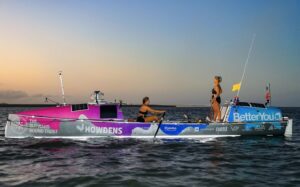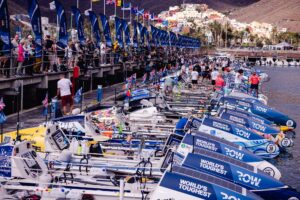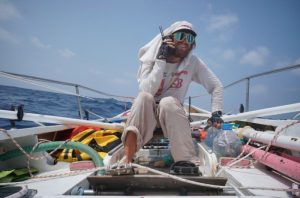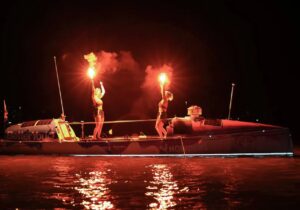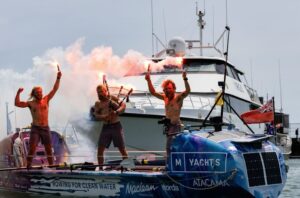Since our last ocean rowing roundup, one soloist has completed his row across the Atlantic, another has set off across the Indian Ocean, and a third continues across the Pacific.
Pacific Ocean
Tom Robinson of Australia began his row in Lima, Peru. After 160 days, he paused on Penrhyn, one of the Cook Islands, for four months to wait out cyclone season. Finally, he took to the ocean again for his second stage on April 14.

Photo: Tom Robinson/Facebook
When he restarted, he was unsure of the route he was going to take to Brisbane. His options were to make the full 5,560km journey to Australia, stop after 2,250km in Fiji, or after 1,600km in Samoa. He has opted for Samoa.
Robinson is now approximately 140km from the Samoan island of Tau. There are two possible landing spots, but they are surrounded by coral. Robinson will need good weather to make it into one of the harbors.

Robinson’s route so far. Image: https://my.yb.tl/tomspacificjourney
If the swells are too big, he will continue on to Western Samoa to rest for a few days, then continue all the way to Australia.
Atlantic Ocean
Aurimas Valujavicus (Latvia) has completed his 9,000km row across the Atlantic Ocean. He started in Spain on December 26, 2022, and finished in Miami on April 25 after 120 days, 14 hours and 18 minutes.

Photo: Aurimas Valujavicius/Facebook
He became the first Lithuanian and third person ever to row alone from Spain to the U.S. When he made it onto dry land, he told reporters that he felt a little bit dizzy but okay.
During the voyage, he rowed for 14 hours every day. He had hoped to break records for distance and speed, but bad weather and large waves slowed him down.
Indian Ocean
Robert Barton (Australia) is rowing across the Indian Ocean from east to west. He began in Carnarvon, Western Australia, and hopes to make it 3,558km to Tanzania. There have only been 42 attempts to cross the Indian Ocean. Only half of them have succeeded, and just seven of those were by soloists.

Photo: Rob Barton/Facebook
He started on April 25, in glassy calm water. It quickly became rougher over the next few days, and he suffered from seasickness. Then a leaking conduit caused a minor flood in his cabin, when stormwater gushed through the vent, soaking almost everything.

Photo: Rob Barton/Facebook
The situation continued to worsen. After 10 days, he was almost ready to quit. He was still sick, only managing two meals a day, and the cabin flooded again. Then the autopilot broke. He had four replacement units with him but has been unable to set them up. But he continues to persevere. He has covered 23 percent of the total journey.

